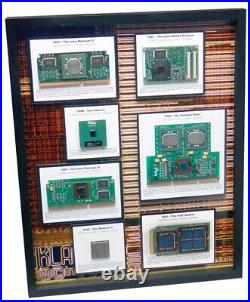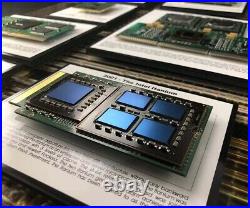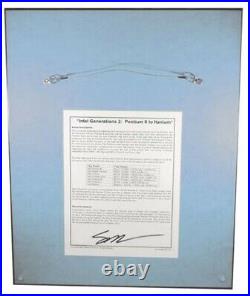Intel the Next Generation Pentium II to Itanium




This artwork is a follow-on to my "Intel Generations - 4004 to Pentium-Pro" artwork. The microprocessors used in this artwork were selected to highlight the many different styles of packaging Intel used for its microprocessors.
These "next generation" microprocessors differed greatly from the previous generations of microprocessors in terms of application and packaging. The differences in packaging technology between the Intel 4004 and these microprocessors is almost as great as the differences in their processing power. Some of these microprocessors have had their plastic covers removed to show their internals, but they are still fully functional.
Here is list of the microprocessors used in this piece: Intel Pentium II. Intel Pentium III, Pentium 4, and Itanium. Also, check out the third artwork in the series, Intel the Third Generation - Xeon MP to i7.The artwork is framed in an 16"x20" black shadow box frame, with glass. All framing materials are acid free. A narrative about the artwork that includes the artists signature is placed on the back of the artwork. Limited to 50, or by availability of chips. Just add all your items to the cart, and then checkout.
Want to see more ChipScapes? Check out my webstore, ChipScapes.
Com, for a greater selection of chips and chip art. Computer chips start out as ordinary sand, which is silicon dioxide.However, the silicon must be made very, very pure. The first step is to melt the sand, in a furnace that reaches about 3200.
F, and mix with carbon. This first purification process creates 99% pure Silicon, a common output is Silicon Carbide.
The Silicon Carbide is processed in a trichlorosilane distillation method to create 99.9999% pure silicon called polycrystalline silicon. The polysilicon is broken up into chunks. These chunks are melted in a crucible at about 2500. A silicon crystal seed is dipped in molten silicon and slowly drawn out to create a cylinder of silicon. These silicon cylinders are some of the purest crystals on the planet.
Once the silicon cylinder is grown to the desired diameter, it is sawed into wafers. These wafers are polished to achieve a very flat mirror surface. Transistors, and other micro-electronic parts, are built on the polished wafer in layers in a process called etching. The wafer is then sawed into its individual chips.Each chip is mounted in an electronic package that serves to protect it and connect it to the outside world. It has been said that computer chips are the greatest value added product in the world. We essentially take a pile of sand and change it into thousands of dollars worth of computer chips. These artworks are the creation of.
Are photographs taken of computer chips, boards, and other computer artifacts. They are sort of chip landscapes, or. Most often a macro-lens or microscope is used with special lightning to achieve these unique artworks. Intel, IBM, Fairchild, DEC, Signetics, Intersil, AMD, Zilog, Motorola, MOS, NEC, Texas Instruments, are some of the great chip making companies.
Chips like the Intel 4004, MOS 6502, Zilog Z80, AMD 2901, IBM PowerPC and others have changed the way people work and play. Are dedicated to preserving and sharing these computing and communication technologies that changed the world. Artworks are fine collectible artworks. Come is a variety of shapes sizes and colors. Clusters of my artwork make for stunning displays!
Would make a great gift for the nerd, geek, engineer, programmer, IT executive, or just that technology savvy person in your life. For more information about ChipScapes. Please check out my ChipScapes. For more information about chip collecting as a hobby. The item "Intel the Next Generation Pentium II to Itanium" is in sale since Wednesday, June 17, 2020.This item is in the category "Art\Mixed Media Art & Collage Art". The seller is "chipscapes" and is located in Winter Park, Florida.
This item can be shipped worldwide.- Original/Reproduction: Limited Edition
- Size: Medium (Up to 30in.)
- Materials: Paper, Silicon, Metal
- Style: Impressionist
- Type: Collage
- Subject: Computer Chips
